Similar Posts
http-equiv=»Content-Type» content=»text/html;charset=UTF-8″>lass=»entry-related-carousel kadence-slide-init splide» data-columns-xxl=»3″ data-columns-xl=»3″ data-columns-md=»3″ data-columns-sm=»2″ data-columns-xs=»2″ data-columns-ss=»1″ data-slider-anim-speed=»400″ data-slider-scroll=»1″ data-slider-dots=»true» data-slider-arrows=»true» data-slider-hover-pause=»false» data-slider-auto=»false» data-slider-speed=»7000″ data-slider-gutter=»40″ data-slider-loop=»true» data-slider-next-label=»Next» data-slider-slide-label=»Posts» data-slider-prev-label=»Previous»>
Second Generation Computers
The Second Generation of computers was a quantum leap in computer technology between 1956 to 1963. Upgrading from the bulky, power-hungry vacuum tubes of First Generation machines to smaller, more efficient transistors allowed for improved performance and reduced energy consumption.
The memory base moved away from simply magnetic storage and incorporated core memories, leading to less heat production while simultaneously improving speed capabilities. With this new advancement in size came an increased capacity for automation that had never been seen before – paving the way for even more significant advancements yet still unknown!
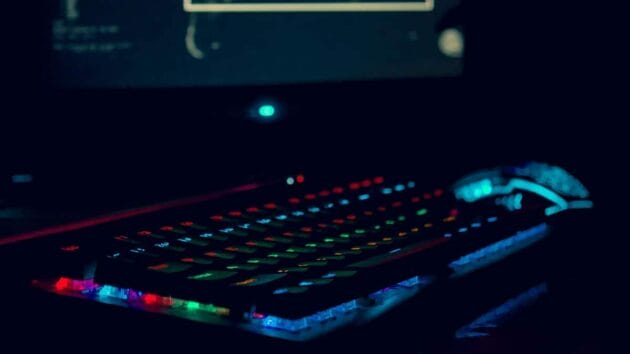
Mark I Computer: Modern Machines
The next big changes in the history of computer began in 1937 when a Harvard graduate student, Howard H. Aiken, invented the first electro-mechanical computer, known as Mark-I.
This computer was capable of solving calculation involving large numbers and advanced mathematical physics problems. Mark-I was become the first digital computer developed by Aiken and the primary engineers of IBM in 1944.
The Mark I was a massive computer machine, measuring over 50 feet in length and weighing over 5 tons. It used punched cards to accept instructions and data, stored them in memory and made calculations with the help of automatically controlled electromagnetic relays.
This machine could perform complex mathematical calculations at a rate of 3 additions or subtractions per second. However, it was extremely slow as compered with modern computers.
The Mark-I was the first machine to use electronic circuits to perform calculations. It was also the first machine to be fully programmable, meaning that it could be reprogrammed to perform different tasks by changing the punched paper tape.
During World War II, the US navy extensively used this computer in the development of ballistic tables. A wide range of scientific research, from astronomy to genetics, also used this computer.
Thus, the Mark I played a significant role in the development of computing technology. It helped to establish the importance of electronic computing in scientific research and paved the way for the development of modern computers and information technology.
In this tutorial, you have known about a fascinating history of computing with timeline as well as a brief history of computers. Hope that you will have understood the basic points of computer’s history.
Thanks for reading!!!
⇐ PrevNext ⇒
Who invented the world’s first electromechanical, the programmable computer?
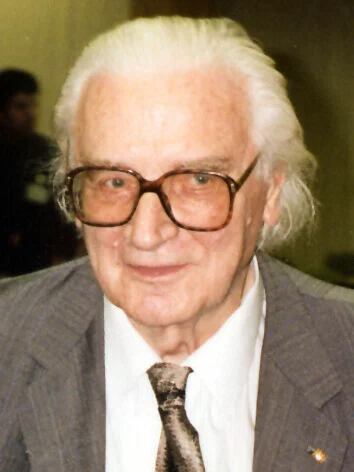
Konrad Zuse
Although largely unknown, Konrad Zuse could win the title of «the man who invented computers»!
In 1938, Germany, Zuse began work on the Z1: a mechanical calculator. It was constructed from around 12,500 individual, hand-cut, sheet metal parts, was self-financed, and was assembled in his parent’s living room. It worked on a binary system and was fed paper tape.
The machine could have been more successful as it produced unreadable results. It was also pretty slow. However, with help from his friend Helmut Freier, an electrical engineer, this formed the basis of the Z2…
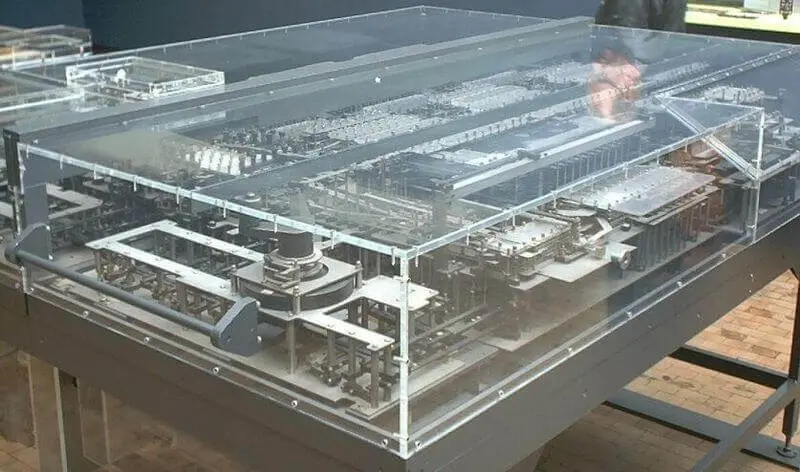
The Z1 (reconstruction). Bombs destroyed the original model during WWII.
The Z2 (1939) was an electromechanical computer that was capable of slightly more varied functions. It took 0.8s to complete an additional operation,n and weighed over 270 kg (600 lbs).
Zuse quickly followed this with the Z3 (1941), the world’s first working electromechanical programmable, fully automatic digital computer. It had a monitor, keyboard, and a 21-inch flatscreen! The user could write and feed programs using a strip of film.
The German Aircraft Research Institute used the Z3 to analyze wing flutter. Zuse requested funding to replace the relays with electric switches but was denied as it was deemed «not war important.”
History of Computers Generation
The word ‘computer’ has a very interesting origin. It was first used in the 16th century for a person who used to compute, i.e. do calculations. The word was used in the same sense as a noun until the 20th century. Women were hired as human computers to carry out all forms of calculations and computations.
By the last part of the 19th century, the word was also used to describe machines that did calculations. The modern-day use of the word is generally to describe programmable digital devices that run on electricity.
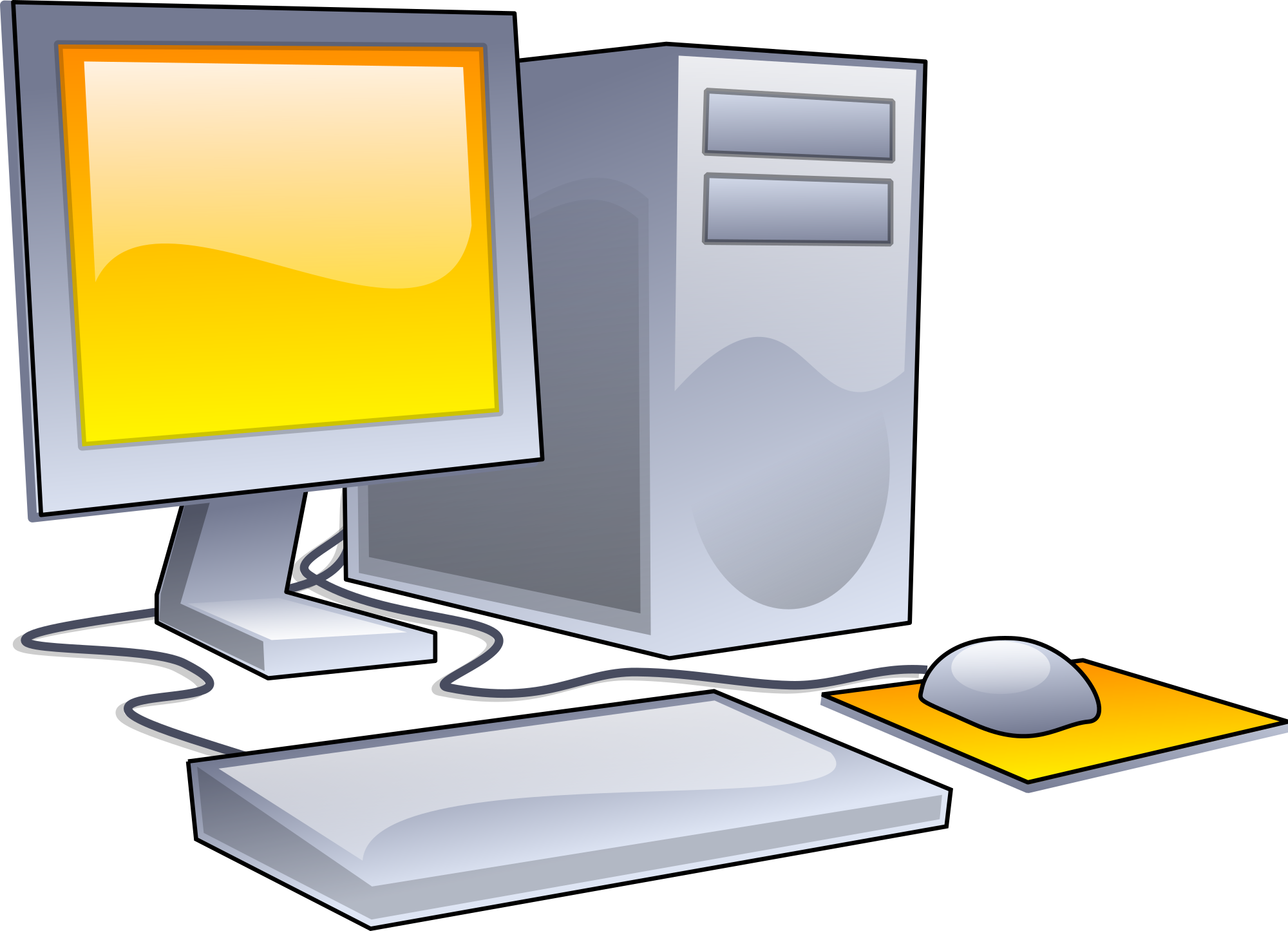
Early History of Computer
Since the evolution of humans, devices have been used for calculations for thousands of years. One of the earliest and most well-known devices was an abacus. Then in 1822, the father of computers, Charles Babbage began developing what would be the first mechanical computer. And then in 1833 he actually designed an Analytical Engine which was a general-purpose computer. It contained an ALU, some basic flow chart principles and the concept of integrated memory.
Then more than a century later in the history of computers, we got our first electronic computer for general purpose. It was the ENIAC, which stands for Electronic Numerical Integrator and Computer. The inventors of this computer were John W. Mauchly and J.Presper Eckert.
And with times the technology developed and the computers got smaller and the processing got faster. We got our first laptop in 1981 and it was introduced by Adam Osborne and EPSON.
Browse more Topics under Basics Of Computers
- Number Systems
- Number System Conversions
- Generations of Computers
- Computer Organisation
- Computer Memory
- Computers Abbreviations
- Basic Computer Terminology
- Computer Languages
- Basic Internet Knowledge and Protocols
- Hardware and Software
- Keyboard Shortcuts
- I/O Devices
- Practice Problems On Basics Of Computers
Computer
Today’s world is often called a computer world and it is truly so. Computer is an electronic device which can carry out a set of instructions. It is difficult to imagine the modern world of high technology without computers. Moreover, it is the fastest growing industry nowadays. Fifty years ago people had no idea what computers are and what they can do. Today, people can’t imagine living a day without them. While the first computer was the size of a minibus, modern devices can fit into a palm. And the computer revolution is still going on.
The first computers were developed during the Second World War to break the codes or send secret information. They were also used to do calculations for the first atom bomb. Today, they are used to store the data, handle banking transactions, manage governmental files, keep statistics etc. Generally, all that computes do is calculate. They turn numbers into pictures, words and sounds. The Japanese have already created the device which responds to human language. Computers have opened a new era in many spheres of life, especially in manufacturing and communication systems.
The word “computer” was first used in 1613 in a book, written by English writer. It referred to a person, who carried out calculations. Soon the first mechanical calculator was invented by Blaise Pascal. However, the actual father of the first recognizable computer was Charles Babbage. In the first half of the 19th century he created a fully programmable mechanical device. The sophisticated analog computers appeared in the 20th century. First functional computer was called Z1 and was created by Konrad Zuse.
Today, nearly everything in the world is done with the help of computers. No man alive can do 500,000 sums in one second, whereas computers can. They have a much better memory and faster reaction. Computers have extended the power of the human mind across the existing barriers. Many fields of science are dependent on this device today. For example, medicine is almost impossible without computers. Over the last 50 years all medical information, discoveries and data have been stored there. Moreover, computers play an integral part in diagnostics and treatment.
Although there are two types of computers, analog and digital, only digital type is widely used in every field. Digital computers perform a number of operations at an unbelievable speed. For example, they can handle 2,000 million discrete operations per second. More enhanced computers handle many billions of cycles per second. There have already been several generations of digital computers or processing units.
Computer science is even taught in modern schools. It’s called IT (Information Technology). Children at secondary schools learn how to handle computing machines and store basic information. Besides using computers for IT lessons, schools need this device for test and examination purposes.
Generations of Computers
In the history of computers, we often refer to the advancements of modern computers as the generation of computers. We are currently on the fifth generation of computers. So let us look at the important features of these five generations of computers.
- 1st Generation: This was from the period of 1940 to 1955. This was when machine language was developed for the use of computers. They used vacuum tubes for the circuitry. For the purpose of memory, they used magnetic drums. These machines were complicated, large, and expensive. They were mostly reliant on batch operating systems and punch cards. As output and input devices, magnetic tape and paper tape were implemented. For example, ENIAC, UNIVAC-1, EDVAC, and so on.
- 2nd Generation: The years 1957-1963 were referred to as the “second generation of computers” at the time. In second-generation computers, COBOL and FORTRAN are employed as assembly languages and programming languages. Here they advanced from vacuum tubes to transistors. This made the computers smaller, faster and more energy-efficient. And they advanced from binary to assembly languages. For instance, IBM 1620, IBM 7094, CDC 1604, CDC 3600, and so forth.
- 3rd Generation: The hallmark of this period (1964-1971) was the development of the integrated circuit. A single integrated circuit (IC) is made up of many transistors, which increases the power of a computer while simultaneously lowering its cost. These computers were quicker, smaller, more reliable, and less expensive than their predecessors. High-level programming languages such as FORTRON-II to IV, COBOL, and PASCAL PL/1 were utilized. For example, the IBM-360 series, the Honeywell-6000 series, and the IBM-370/168.
- 4th Generation: The invention of the microprocessors brought along the fourth generation of computers. The years 1971-1980 were dominated by fourth generation computers. C, C++ and Java were the programming languages utilized in this generation of computers. For instance, the STAR 1000, PDP 11, CRAY-1, CRAY-X-MP, and Apple II. This was when we started producing computers for home use.
- 5th Generation: These computers have been utilized since 1980 and continue to be used now. This is the present and the future of the computer world. The defining aspect of this generation is artificial intelligence. The use of parallel processing and superconductors are making this a reality and provide a lot of scope for the future. Fifth-generation computers use ULSI (Ultra Large Scale Integration) technology. These are the most recent and sophisticated computers. C, C++, Java,.Net, and more programming languages are used. For instance, IBM, Pentium, Desktop, Laptop, Notebook, Ultrabook, and so on.
The first stored program computer
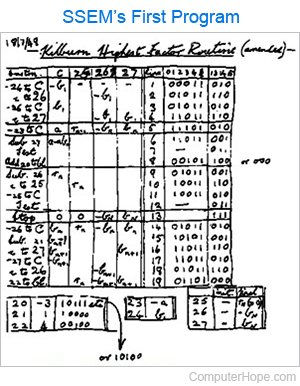
The first computer to electronically store and execute a program was the SSEM (Small Scale Experimental Machine), also known as the «Baby» or «Manchester Baby,» in . It was designed by Frederic Williams and built by his protégée, Tom Kilburn, with the assistance of Geoff Tootill, at the University of Manchester, England. Kilburn wrote the first electronically-stored program, which finds the highest proper factor of an integer using repeated subtraction rather than division. Kilburn’s program was executed on June 21, .
The second stored-program computer was also British: the EDSAC (Electronic Delay Storage Automatic Calculator), built and designed by Maurice Wilkes at the University of Cambridge Mathematical Laboratory in England. The EDSAC performed its first calculation on May 6, . It was also the first computer to run a graphical computer game, «OXO,» an implementation of tic-tac-toe displayed on a 6-inch cathode ray tube.
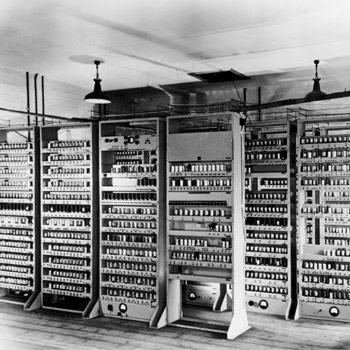
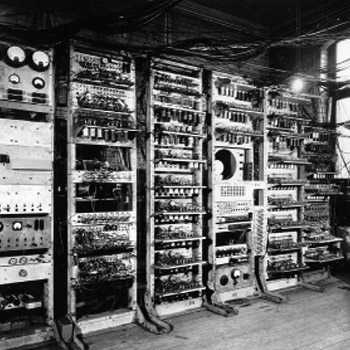
Around the same time, the Manchester Mark 1 was another computer that could run stored programs. Built at the Victoria University of Manchester, the first version of the Mark 1 computer became operational in April . Mark 1 was used to run a program to search for Mersenne primes for nine hours without error on June 16 and 17 that same year.
Доклад на тему История компьютера сообщение
В современном мире компьютеры используются постоянно, и на работе, и в быту. Сейчас сложно представить человека, не имеющего компьютера или хотя бы элементарных знаний по его использованию. Однако всего несколько десятилетий назад все было совсем иначе.
Авторство компьютера не приписывается одному конкретному человеку, так как он был создан совокупным трудом многих ученых на основе целого ряда изобретений. Есть версия, что главным толчком к появлению компьютера стала машина Z1, созданная немецким изобретателем Конрадом Цузе в 1936 году. Ее можно было свободно программировать, а некоторые принципы вычисления, придуманные Цузе, используются в современных калькуляторах до сих пор.
Считается, что впервые настоящий компьютер создали в США в Айове. Его разработчиками были профессор Атанасов со своим аспирантом. В нем использовались конденсаторы и электронные лампы наряду с некоторыми механическими компонентами. Однако этот проект не получил широкого распространения. Тем не менее, на его основе были созданы вычислительные машины Mark, появившиеся в годы мировой войны. В США в 1943 году Mark 1 использовался для вычислительных операций при военном ведомстве. Создателем этой машины был Говард Эйкен.
Примерно в это же время перед группой ученых была поставлена задача создания компьютера. Тогда и был создан знаменитейший ENIAC – настоящая ЭВМ, которую и сейчас многие определяют как самый первый из созданных компьютеров.
Компьютер ENIAC, как и детище Эйкена, был создан с использованием электронных ламп. Всего их было использовано почти 20000. Для размещения всех компонентов вычислительной машины потребовалось значительное пространство. Огромная машина располагалась на площади более 300 м².
Несмотря на значительный прорыв в разработке вычислительной техники, сам первый компьютер проработал очень непродолжительное время. Из-за высокой нагрузки электронные лампы постоянно выходили из строя, а из-за недостатков конструкции и отсутствия дублирующих систем при перегорании одной лампы машина полностью прекращала работу.
В 1949 году ENIAC заменили более совершенной моделью – появился компьютер EDSAC. Он вошел в историю как первая ЭВМ, в памяти которой можно было записать и сохранить программу. Следующие за ним машины уже использовали магнитную ленту, на которой сохранялись все необходимые данные. В то же время появился транзистор – устройство, которое произвело революцию в вычислительной технике. Первый транзисторный компьютер, вышедший в 1955 году, выгодно отличался от предыдущих моделей компактностью и надежностью.
Первый в мире компьютер, который смело можно было называть персональным, создала в 1964 году компания IBM. В его основе были созданные на транзисторах интегральные схемы, позволившие создать устройство небольшого размера и обеспечившие его быстродействие. Именно для машин этого поколения впервые были разработаны операционные системы.
А в 1971 году появился компьютер на основе микропроцессора. Это уже была именно та машина, которая, значительно усовершенствовавшись, стала современным персональным компьютером.
The Inside World of a Computer Case
If you look inside a computer case (not the empty one I mean)
you will see many parts and a confusing mass of data cables and
power cords. Especially, you should be able to see some of the most
important and widely known parts such as the following:
1. System board or the mother board consisting of the CPU and
the accompanying microchip/s or chipset, a coprocessor (in case
of old computers), system clock, ROM BIOS, Random Access Memory
(RAM), cache memory (optional), flash BIOS, CMOS configuration chip
with its battery, power supply connections, system bus with expansion
slots, jumpers and dip switches and ports. Of these some (CPU, ROM,
BIOS etc.) are replaceable or upgradeable while other are not. The
system board is the most complicated part of a computer hardware
where most of the activity takes place. It is very much like the
brain with which all the devices in the computer need to communicate
some how. A system board as the name implies manages the performance
of all other devices that are connected to it either internally
or externally.
2. Depending upon the configuration storage devices such as one
or two floppy drives, one or more hard drives, one ore more CD-ROM/DVD-ROMs,
Zip drive and so on.
3. A power supply that receives electricity from outside and
then supplies it to all the devices inside the case. It usually
contains a cooling fan on the back to protect itself and other computer
hardware from over heating.
4. Circuit boards which enable the CPU to communicate with other
devices both with in and outside the computer case. The circuit
boards contain microchips or integrated circuits, which can be either
CMOS (complimentary metal oxide semiconductor) chips or TTL (transistor-transistor
logic) chips. These chips differ in their functionality and also
the way they use electricity, manage heat and hold the data. But
we won’t go into these minor details.
5. Storage devices. The storage devices inside a CPU are either
primary storage devices or secondary storage devices. The primary
storage devices help the CPU to process data or instructions by
holding information temporarily. They are therefore temporary storage
devices and the memory they hold is called volatile memory.
Primary Storage Devices: The most common type of primary storage
devices are the memory chips which can hold either random access
memory (RAM) or cache memory or both. If cache memory is stored
on the system board it is called COAST (cache on a stick).
Secondary Storage Devices: In contrast to primary storage devices,
the data that is stored here is more permanent. that is they can
hold the data even when the computer has been switched off and will
remain so until some external agent or device physically removes
the data. Anther big difference is while the the CPU can process
the data residing in the primary storage devices directly, it cannot
do so with the data residing in the secondary storage devices. For
that the data need to be moved to the primary storage device.
This in brief is the basic configuration of computer hardware.
Пользуемся преимуществами AIDA 64
Многие читатели спросят нас: «Какая самая продвинутая программа для просмотра характеристик ПК?». Мы отвечаем – AIDA 64».
Этот великолепный инструмент является наследником лучшей в мире программы подобного рода – Everest» (которая, к слову, уже давно не поддерживается). Аида подойдет всем без исключения, начиная от новичков и заканчивая оверклокерами и компьютерными инженерами. AIDA 64 хороша тем, что проверяет всю систему, снимает показания со всех датчиков и предоставляет информацию в понятном удобном виде на русском языке. Еще два плюса ‒ наличие техподдержки и частые обновления базы данных.
Почему мы не советуем AIDA 64 всем? Она является платной. На сентябрь 2018 года цена программы составляет 2265 рублей, что делает ее недоступной основной массе пользователей. Однако есть пробная 30-дневная лицензия, которой хватит для решения некоторых технических проблем с компьютером.
Рассмотрим возможности AIDA 64 подробнее.
- Скачиваем и устанавливаем программу с официального сайта разработчиков https://www.aida64russia.com. Нам нужна версия «AIDA64 Extreme for home».
- Соглашаемся с условиями 30-дневной лицензии и переходим к самой программе. Интерфейс AIDA 64 разбит на две части. В левой содержится список вкладок с параметрами работы аппаратной и программной части компьютера. В правой – их содержание. Нас больше всего интересует вкладка «Компьютер/Суммарная информация». Тут присутствуют все основные сведения о параметрах ПК.
- Крайне полезной является вкладка «Датчики». Тут указана температура и напряжение всех силовых цепей компьютера, включая напряжение по линии +3.3В и +12В блока питания, на северном мосту и батарее BIOS. Еще тут указано число оборотов вращения вентилятора охлаждения центрального и графического процессора.
- Для компьютерных инженеров, мастеров и любителей компьютерного железа предусмотрена вкладка «Системная плата». Тут вы можете ознакомиться со всеми параметрами материнской платы и устройств, установленных на ней. Руководствуясь этой справкой, можно производить разгон и настройку системы с максимальной точностью.
- Пункт «Операционная система» предоставляет соответствующие данные о программной части ПК и ее отдельных компонентов.
- Чтобы узнать все свойства системы касательно видеоадаптера, нужно открыть вкладку «Отображение». В ней отображаются свойства и состояние графической подсистемы в режиме реального времени.
- Пункт «Хранение данных» предоставляет данные об установленных винчестерах, твердотельных накопителях и приводах чтения оптических дисков. Крайне полезным можно назвать пункт SMART», отображающий текущее состояние жестких дисков.
Остальные вкладки не менее полезны предыдущих, но используются большей частью пользователей на порядок реже.
Преимущества
- Предоставляет абсолютно всю информацию о системе и конкретно выбранном устройстве.
- Работа AIDA 64 основана на снятии показаний с датчиков и предоставлении информации об устройстве из баз данных разработчиков.
- Несмотря на огромные объемы отображаемых параметров, Аида 64 проста в использовании.
- Качественный перевод на русский язык.
- Может работать на любом морально устаревшем ПК.
6. Смотрим файл журнала
Для проверки журнала Вашей ОС нужно открыть «Панель управления» и найти функцию «Администрирование». После этого кликнуть на «Управление компьютером» и в навигационной панели найти вкладку «Просмотр событий». Итак, к Вашим услугам будут представлены несколько журналов – «Безопасность», «Установка», «Система» и «Приложение».
Журналы эти имеют массу нужной информации о жизнедеятельности юзеров, ошибках приложений, загрузках, и прочего.
Журнал безопасности
В этом месте производится фиксация всех событий, чтобы просмотреть этот журнал попробуйте открыть окно просмотра событий и в журнале «Windows» выберите вкладку «Безопасность». Теперь Вы увидите события безопасности. Для того, чтобы узнать дополнительные сведения о каком-либо событии достаточно будет нажать на него и изучить полученную информацию.
Отметим, что этот журнал в обязательном порядке включает информацию о входе в систему. Если Вы знаете о своих входах в систему, то Вы всегда сможете идентифицировать время входа постороннего человека.
Журнал приложений
Включает в себя информацию о том, что за приложения открывались с Вашей машины. Когда Вы пытаетесь понять, какие приложения использовались, когда Вас не было в Ваше отсутствие сделайте фильтрацию по дате в событиях.
Desktop Virtualization
Computers will not only get more powerful, but they will also get virtual. Offices and workspaces will get digital, in a way that they will offer users to use them virtually. Desktop Virtualization is a technology that will broaden the scope and make organizations connect their resources with others from a global perspective.
Desktop Virtualization, in the simplest sense, is a way to make the computer accessible from anywhere and by anybody. Remote users can log on to the computer from any corner of the earth and operate it virtually. Desktops will become virtual so that it gets connected to a network. Operating systems and applications will be located in a cloud server, and users can access it from anywhere.
Any computer, laptop, smartphone, a tablet can get virtual and behave as a virtual desktop. This Desktop Virtualization technology pools resources to get connected easily across so many platforms and make data more secure and safe.
Hollerith 1890 Census Tabulator
Herman Hollerith a German mathematician created and invented the tabulating machine utilizing punch cards for registration in the USA,
The cards used to have gaps when the cards went through machines the machine distinguished the gaps and afterwards the machine could recognize the numbers and later the machine could make important calculations
Second World War Computers During the Second World War numerous nations were fabricating and building new outlines and new designs for Aircraft,
Modern computers were utilized as a part of mystery military operations, and with the help of cutting-edge machines, they were decoding the messages.
In this war PC’s assistance and help were unfathomable in illuminating numerous repetitive and tedious issues that only they could explain,
The computers that were utilized as a part of the war were named Z1 and Z2 ComputersGerman build Konrad Zuse (1910– 1995) built his PC Z1 to Z4 impacted the Second World War.
- What are Input Devices of Computer
- What are Output Devices of Computer
- What is a Computer Virus
- What is Computer Hardware and Software
- What is a Computer Memory
Timeline of Computer History
| Year |
Event |
|---|---|
| 1801 |
Joseph Marie Jacquard created a loom in France that renders punched wooden cards. |
| 1822 |
English mathematician Charles Babbage developed a calculating device called the Analytical Engine, which computes number tables. |
| 1890 |
Herman Hollerith devised a punch card system to compute the 1880 census, executing the task for merely three years, preserving the government $5 million. |
| 1936 |
Alan Turing proposed the concept of a universal machine, subsequently dubbed the Turing machine, competent in computing anything computable. |
| 1937 |
J.V. Atanasoff, a Physics and Mathematics Professor at Iowa State University, attempted to construct the first computer lacking shafts, gears, or belts. |
| 1941 |
J.V. Atanasoff and his graduate student, Clifford Berry, invented the computer that could decrypt 29 equations simultaneously. |
| 1943-1944 |
Pennsylvania Professors John Mauchly and J. Presper Eckert designed the Electronic Numerical Integrator and Calculator (ENIAC). |
| 1946 |
After acquiring finance from the Census Bureau, Mauchly and Presper developed the UNIVAC, the first saleable computer. |
| 1953 |
Grace Hopper developed the first computer language, becoming known as COBOL. Thomas Johnson Watson Jr., the son of IBM CEO Thomas Johnson Watson Sr., created the IBM 701 EDPM, assisting the United Nations in holding invoices on Korea during the war. |
| 1958 |
Jack Kilby and Robert Noyce reveal the integrated circuit, well-known as the computer chip. |
| 1964 |
Douglas Engelbart reveals a prototype of the current computer, having a mouse and a Graphical User Interface (GUI). |
| 1970 |
The newly initiated Intel reveals the Intel 1103, the first Dynamic Access Memory (DRAM) chip. |
| 1971 |
Alan Shugart directs a team of IBM engineers who developed the floppy disk permitting data to be shared among computers. |
| 1973 |
Robert Metcalfe, a member of the research team for Xerox, developed an Ethernet, linking numerous computers and other hardware. |
| 1974-1977 |
Many personal computers hit the demand, including the IBM 5100, Scelbi& Mark-8 Altair, and Radio Shack’s TRS-80. |
| 1976 |
According to Stanford University, Steve Jobs and Steve Wozniak initiated Apple Computers, the first computer holding a single-circuit board. |
| 1981 |
The first IBM personal computer, presented on 12 August 1981, operated the MS-DOS operating system. |
| 1986 |
Compaq brought the Deskpro 386 to demand. Its 32-bit architecture furnishes a speed equivalent to mainframes. |
| 1990 |
Tim Berners-Lee, a researcher at CERN, originated the HyperText Markup Language (HTML), offering elevation to the World Wide Web. |
| 2004 |
Facebook, a social networking site, takes off. |
| 2005 |
YouTube, a video-sharing service, was established. |
| 2007 |
The iPhone fetches many computer functions to the smartphone. |
| 2009 |
Microsoft released Windows 7, which can pin applications to the taskbar and write recognition. |
| 2011 |
Google launched the Chrome Book, a laptop that operates on Google Chrome OS. |
| 2019 |
Apple declared iPadOS for their tablet appliances in June. |
| 2020 |
The Microsoft Internet Games service was terminated for Windows 7 on 22 January. |
| 2021 |
Apple launched the Apple AirTag. |
Found This Page Useful? Share It!
Get the Latest Tutorials and Updates
Join us on Telegram
Future of Computers
What does the future hold for computers? We may be surprised to see how much has changed from today! There could be no physical machines as we know them – instead, advanced computing systems might fit within our bodies or on a piece of jewelry. Humans will continue to control these technologies though; this is something that isn’t likely to change in what lies ahead!
The future is here! Robotic systems are rapidly evolving and computers have become an integral part of our lives, providing us with a more luxurious lifestyle. Breakthroughs in many domains such as science, technology, and biotechnology continue to revolutionize the capabilities of computer-based technologies – making futuristic dreams a reality.
Imagine a future where your home is brimming with possibilities thanks to the Fifth Generation of Computers. We’re already seeing glimpses of these devices in action today, providing us with sleek and integrated systems that allow for unprecedented control over our electronic equipment. As technology continues to evolve, humanity can unlock countless potential opportunities through this remarkable generation of computers!
Exploring the Inventors Behind the First Computer
Although the ENIAC was the first computer to be developed and used, there were other inventors who contributed to its development. These include Charles Babbage, Konrad Zuse, and John Atanasoff.
Charles Babbage was an English mathematician and inventor who is often credited as the “father of the computer.” He developed the concept of the difference engine, which was a mechanical calculator that could solve complex mathematical equations. Babbage’s work laid the foundation for the development of the first computers.
Konrad Zuse was a German engineer who developed the Z3, the world’s first programmable, fully automatic computer. The Z3 was the first machine to use binary code and floating point arithmetic, two concepts that are still used in modern computers.
John Atanasoff was an American physicist who developed the Atanasoff-Berry Computer (ABC), the first digital computer. The ABC was the first machine to use electronic circuitry, and it was the first to be able to store and retrieve data from memory.
Computer & CAD
Today, computers play a crucial role in various industries, including architecture, engineering, and construction. Computers in these fields have led to the development of computer-aided design (CAD) software, allowing architects, engineers, and construction professionals to create detailed, three-dimensional models of buildings and structures.
One such CAD software is BricsCAD, a powerful CAD software that provides architects, engineers, and construction professionals with the tools they need to create accurate, detailed, and professional-looking drawings. BricsCAD offers a wide range of features, including 3D modeling, drafting, and design tools, and is known for its intuitive interface and powerful functionality.
In conclusion, the invention of the computer has come a long way since its inception in the 19th century. Today, computers play a vital role in various industries, and BricsCAD is one example of how technology has transformed the architecture, engineering, and construction fields. Whether you’re a seasoned professional or just starting, BricsCAD provides the tools you need to bring your designs to life.
Further reading:
- Timeline of computing history
- The Guardian — History of the internet
- BBC News — Difference Engine No 2 built
- The Jacquard Loom punch card
- The history of the Z1, Z2, Z3 and Z4 computers
- Encyclopedia Britannica — The Personal Computer
- The Micral computer
- On Computable Numbers, with an Application to the Entscheidungsproblem, Alan Turing, 1936.
- Etym Online — The word «computer»
- IBM website — the IBM 608 transistor calculator and other 1955 developments
Download BricsCAD Free Trial | Sign Up For News & Updates | Shop Online For BricsCAD Desktop Software
The second generation of computers
Back in 1947, transistors were invented.In the late 50’s. they replaced energy-consuming and fragile lamps. With the advent of transistors, the computing machine began a new history of creation. The computers that received these new parts were later recognized as models of the second generation. The main innovation was that PCBs and transistors allowed to significantly reduce the size of computers, which made them much more practical and convenient.
If before computers occupied whole rooms, thennow they have decreased to the proportions of office desks. Such, for example, was the IBM 650 model. But even the transistors did not solve yet another important problem. Computers were still very expensive, which was why they were made only to order for universities, large corporations or governments.

First mechanical computer or automatic computing engine concept
In , Charles Babbage conceptualized and began developing the Difference Engine, the first automatic computing machine to approximate polynomials. The Difference Engine could compute several sets of numbers and make hard copies of the results. Babbage received some help with developing the Difference Engine from Ada Lovelace, who was considered the first computer programmer for her work. Unfortunately, because of funding, Babbage could never complete a full-scale functional version of this machine. In June , the London Science Museum completed the Difference Engine No. 2 for the bicentennial year of Babbage’s birth and later completed the printing mechanism in 2000.















![History of computer - short summary [2023] | superprof](http://portalcomp.ru/wp-content/uploads/8/1/f/81fe22c10259dbbb24b45d2b81bea4be.jpeg)












